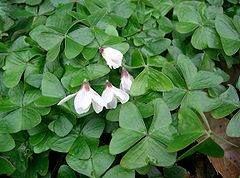Eradicating Oxalis – some options
Oxalis is a weed that frustrates many gardeners to no end. It appears as a simple weed to remove, just dig out the plant, keeping intact the main bulb and the little ‘bulblet’s’ that are clinging to it, then remove for safe disposal. But no matter how careful you are, there are going to be little bulbs that elude your endeavours.

Oxalis griffithii
I have known gardeners that have sieved the soil in an oxalis patch only to find that the problem of the weed reappears sometime later as the tiny bulbs mature.
There are a number of ways to eradicate this pest weed using chemicals or natural means, but none give a quick solution, and one can expect that it will take about two years to completely control. That is as long as you don’t work the soil and cause more ‘bulblet’s’ to break free from the parents.
In natural controls the first law of nature is ‘No weed can sustain itself indefinitely without leaves’. Leaves produce the energy from the sun to maintain the bulb, rhizome or root system, deny any plant its foliage and the plant must die.
So a simple answer is to cut off all the leaves. The bulb will of course, throw up another set of leaves quickly, to compensate and as soon as these appear you remove them.
Keep doing this and by not allowing the bulb to gain energy from the sun, the bulb uses up all its energy producing leaves, till it can no longer do so.
How do you remove leaves or foliage quicker than cutting them off?
Mix a table spoon or two of Baking Soda into a litre of warm water and add 1 ml of Raingard. Spray the foliage on a sunny day when the soil is on the dry side. This will dehydrate the leaves and the bulb will need to produce another set. You could spray with a natural oil based product such as Greenscape from Yates that dehydrates the foliage. This is best done on a sunny day when the soil is on the dry side. You may find that cheap cooking type oils will also do this for you and it’s just a matter of finding a dilution rate that works well and gives an economic use rate. As the oil does not mix well with water add some dish washing liquid to the oil and then mix with water.
Try at full strength on a patch initially, if that works well then dilute half and half with water and see how that goes. Vinegar sprayed over the foliage also works.
For those that don’t mind chemical weed killers then a product such as Roundup can be diluted with water, with Raingard added and either spray or wipe the mix over the foliage.
No matter which method you use after spraying or wiping, do not disturb the soil.
Another show of foliage will appear and this should be treated as soon as possible, as it appears. You can make life harder for the next new lot of foliage, by spreading a couple of inches of compost over the area. Foliage will still come through, but it takes a lot more energy for it to happen. The new foliage should be quickly killed or cut off.
A few layers of newspaper or even a layer of cardboard before the compost layer will also help greatly.
If you can avoid planting anything in the area for a year it will also make the task of complete eradication easier. When you do come to plant, say annuals or vegetable in the area, put another good layer of compost over first and plant the seedlings into this layer. This ensures that the bulbs below will not be dispersed.
Spot treatments will be needed for a further 12 months or so and then you should be right on top of the problem. I would not dig the area for a few more years, to be completely sure and instead just add another layer of compost every time you plant up.
Burying the problem of oxalis is the final key to success.
Another method is place a metre square cage over the soil where oxalis is thriving and into the cage place two or three chickens. They will over a period of days clean up the weed nicely and eat the bulbs.

